

Maasai people. The Maasai (sometimes spelled "Masai" or "Masaai") are a Nilotic ethnic group of semi-nomadic people inhabiting Kenya and northern Tanzania.
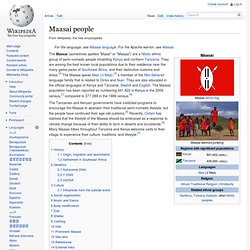
They are among the best known local populations due to their residence near the many game parks of Southeast Africa, and their distinctive customs and dress.[3] The Maasai speak Maa (ɔl Maa),[3] a member of the Nilo-Saharan language family that is related to Dinka and Nuer. They are also educated in the official languages of Kenya and Tanzania, Swahili and English. The Maasai population has been reported as numbering 841,622 in Kenya in the 2009 census,[1] compared to 377,089 in the 1989 census.[4] Toltec. Archaeology[edit] Some archaeologists such as Richard Diehl, argue for the existence of a Toltec archaeological horizon characterized by certain stylistic traits associated with Tula, Hidalgo and extending to other cultures and polities in Mesoamerica.
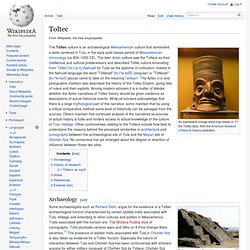
Traits associated with this horizon are: The Mixteca-Puebla style of iconography, Tohil plumbate ceramic ware and Silho or X-Fine Orange Ware ceramics.[1] The presence of stylistic traits associated with Tula in Chichén Itzá is also taken as evidence for a Toltec horizon. Especially the nature of interaction between Tula and Chichén Itzá has been controversial with scholars arguing for either military conquest of Chichén Itzá by Toltecs, Chichén Itzá establishing Tula as a colony or only loose connections between the two. The existence of any meaning of the Mixteca-Puebla art style has also been questioned.[2] A contrary viewpoint is argued in a 2003 study by Michael E.
History of research[edit] Carved relief of a Jaguar at Tula, Hidalgo. Aboriginal Australians. Australian Aboriginal Flag Aboriginal dwellings in Hermannsburg, Northern Territory, 1923.
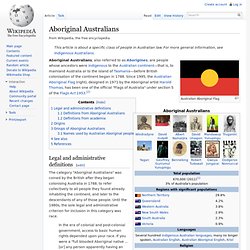
Image: Herbert Basedow Legal and administrative definitions[edit] The category "Aboriginal Australians" was coined by the British after they began colonising Australia in 1788, to refer collectively to all people they found already inhabiting the continent, and later to the descendants of any of those people. Until the 1980s, the sole legal and administrative criterion for inclusion in this category was race. In the era of colonial and post-colonial government, access to basic human rights depended upon your race.
The change to Section 51(xxvi) gave the Commonwealth parliament the power to make laws specifically with respect to Aboriginal peoples as a "race". It is unnecessary, for the purposes of the present case, to consider the meaning to be given to the phrase "people of any race" in s. 51(xxvi). Definitions from Aboriginal Australians[edit] Dogon people. The Dogon are an ethnic group living in the central plateau region of the country of Mali, in Western Africa, south of the Niger bend, near the city of Bandiagara, in the Mopti region.
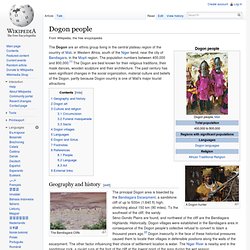
The population numbers between 400,000 and 800,000.[1] The Dogon are best known for their religious traditions, their mask dances, wooden sculpture and their architecture. The past century has seen significant changes in the social organization, material culture and beliefs of the Dogon, partly because Dogon country is one of Mali's major tourist attractions. A Dogon hunter Geography and history[edit] The Bandiagara Cliffs The principal Dogon area is bisected by the Bandiagara Escarpment, a sandstone cliff of up to 500m (1,640 ft) high, stretching about 150 km (90 miles). Among the Dogon several oral traditions have been recorded as to their origin.
Dogon art[edit] Dogon wood sculpture, probably an ancestor figure, 17th-18th century Dogon art is primarily sculpture. Xingu peoples. Xingu peoples are indigenous peoples of Brazil living near the Xingu River.
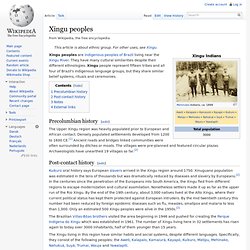
They have many cultural similarities despite their different ethnologies. Xingu people represent fifteen tribes and all four of Brazil's indigenous language groups, but they share similar belief systems, rituals and ceremonies. Precolumbian history[edit] The Upper Xingu region was heavily populated prior to European and African contact. Densely populated settlements developed from 1200 to 1600 CE.[1] Ancient roads and bridges linked communities were often surrounded by ditches or moats. Post-contact history[edit] Kuikuro oral history says European slavers arrived in the Xingu region around 1750.
The Brazilian Villas-Bôas brothers visited the area beginning in 1946 and pushed for creating the Parque Indígena do Xingu which was established in 1961. The Xingu living in this region have similar habits and social systems, despite different languages. Cheyenne people. Navajo people. Sioux. The Sioux /ˈsuː/ are a Native American and First Nations people in North America.

Apache. Apache (/əˈpætʃiː/; French: [a.paʃ]) is the collective term for several culturally related groups of Native Americans in the United States originally from the Southwest United States.
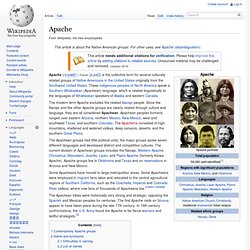
These indigenous peoples of North America speak a Southern Athabaskan (Apachean) language, which is related linguistically to the languages of Athabaskan speakers of Alaska and western Canada.